What does it mean to be a great VP of Product and how do you hire the right person to fill this role in your company? Think of a VP Product like the oil that makes the machine run efficiently and a bad VP of Product like sand that breaks down a machine slowly.
Satya Patel, Partner at Homebrew, takes the Hypertactical stage to talk to Jon Stross, Co-Founder at Greenhouse.io; Ciara Peter, VP Product at Betterworks; and Zack Smocha, VP Product at Rainforest, about how you should think about the role of VPP.
They’ll answer questions like, What are the characteristics should you be looking out for? What should the VP of Product be doing in the company? How do you build structures for your product organization? This session is a must-see if you need some advice that you can put into action today.
And if you haven’t heard: SaaStr Annual will be back in 2018, bigger and better than ever! Join 10,000 fellow founders, investors and execs for 3 days of unparalleled networking and epic learnings from SaaS legends like Eric Yuan, Tomasz Tunguz, Chris O’Neill, and Mikkel Svane. If you don’t have tickets, lock in Early Bird pricing today and bring your team from just $999! (All ticket prices go up December 1st.) Get tickets here.
TRANSCRIPT
Announcer: Please welcome Satya Patel, former VP of Product at Twitter, and currently a partner at Homebrew Ventures.
Satya Patel: Thank you. Is this on? Thank you so much. We recognize we’re the only things standing between you and lunch, but I guarantee you we’re going to make it worth your while.
We have a group of stellar product management executives who are going to shed some light on what it means to be a VP of Product. Let me get started by introducing those folks.
First is Ciara Peter, Head of Product at BetterWorks. Ciara has also held various design roles at Salesforce over many, many years. Welcome, Ciara. Come on up.
Satya: Jon Stross. Jon is co founder and VP of Product at Greenhouse, a long time project manager over the last couple of decades. Thanks, Jon.
Satya: Finally, Zack Smocha, VP of Product at Rainforest QA. Zack has held various product management and product marketing roles at a number of companies over time.
Zack Smocha: That’s bright.
Satya: We’re so far apart from each other.
Ciara Peter: It’s so comfortable.
Satya: We’re going to start with the obvious question. What is the role of a VP of product? Who wants to dive in? Maybe Zack. Do you want to start on the far end?
Zack: What’s the role of a VP of Product? I think it really pours into three things. One is strategy, making sure the company really knows what it’s doing.
Who they sell, what they sell, how they sell. Manage that process over time. The second thing is the minutia of what you really are supposed to do, which is make sure there is a velocity between PM, between engineering, customer feedback.
The third thing is the go to market, which is all about supporting sales, supporting marketing, and pricing, all of those things. Those three functions, if you execute on them, then you’re in a good place.
Satya: Jon.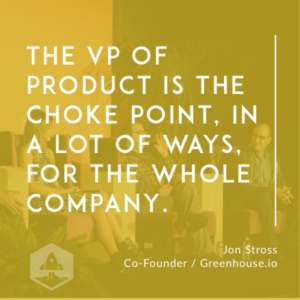
Jon Stross: To add to that rather than repeating it, I think the other thing we think about a lot is that the VP of product is the choke point, in a lot of ways, for the whole company.
You’re listening to all the different things coming in, whether it’s requests from customers or future customers or what your engineering team needs to be done or your kind of vision that you’re doing.
Inevitably, you can’t do all of it, and you’re the one trying to decide which stuff you’re going to do, and what you’re not going to do.
Inevitably, it means you’re saying no to a lot of stuff. A lot of times you’re the person saying no, but also, you’re the person who has to make everyone believe, and say, “Even though we’re not doing the thing that you want today, hang in there with us, we’re going to get there.”
There’s a whole thing of, both internally and externally, you’re the one who has to make everyone believe, even when you can’t do everything they want.
Satya: Communication’s so central to the role. Ciara, I’m curious of your perspectives.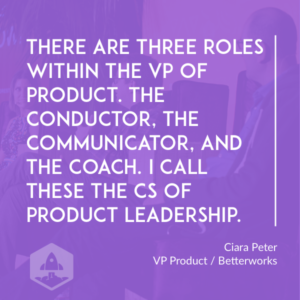
Ciara: I’d say that there are probably three roles within the VP of product. The conductor, the communicator, and the coach. I call these the Cs of product leadership. What that means is, as a conductor the product is your orchestra. It’s up to you to set the tone for the organization by setting really, really clear goals and metrics.
Then also, these cadence activities that will happen within your organization. The more you can automate that, I think the more time there is for your team to be strategic. Communicator, like John mentioned, you’re this bottleneck of information.
You’ve got to communicate upward to let the COO know how you’re executing in the vision. Communicate downward so the team can be agile, and make changes quickly. Then outward, so that your customers know what’s going on.
Then finally, on the coaching side, I would say there is the traditional coaching activities, like frequent feedback, we know that that’s super important. I can’t say there is one week where there is not one piece of feedback, whether positive or constructive, that you can’t give feedback to someone on the team.
Also, helping them understand frameworks to use, so that they can put them in their arsenal to use moving forward and scale.
Satya: Yeah, that’s great. I often talk about it as mobilize, prioritize, optimize, and recognize. That last piece is pretty important in the context of being VP of product. That leads me to my next question. What makes a great VP of product, and what’s the difference between a VP versus a product manager? Zack, do you want to take that?
Zack: Sure. There are two things which I think make a big difference to be a great VP product. One is sales support. In my mind, the product team needs to be the team that support sales, support new deals, support saving a renewal.
It’s time consuming, it makes the product team flying a lot, but I think you just have to do it and that makes your team unique in the organization.
To take the right decisions to drive the organization. The second thing is, we’re all again busy with what we’re doing day to day. I think a good VP product, an excellent one, would always look beyond where the customers are today and what the market is today.
If you have that figured out all the time, then you can always make sure your company has the competitive advantage.
I found that working with the CTO group is probably the best way to achieve that. I feel that really makes you a great VP product.
Satya: Jon, you’re VP of product. You’ve worked with many VP of your products at different companies over the course of time. What have been the characteristics of the great ones?
Jon: There are two different things. One is the leadership thing, of whether it’s having the vision of where we’re going that’s unique and differentiated, so you’re not purely being reactive to everything.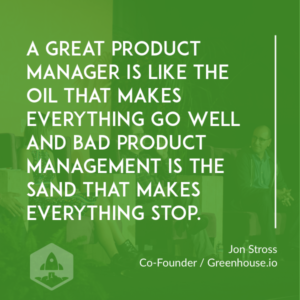
The other thing I’ve seen is just product management, like in the metaphor of the engine of a product team or of an engineering team is, a great product manager is like the oil that makes everything go well and bad product management is the sand that makes everything stop.
It’s a subtle thing. If we think you’re the driver of the bus, it’s like, “Well, sort of,” but, actually, the you’re one who makes everyone better or you make everybody worse. In in a lot of ways, it’s a subtle thing.
It’s hard to tell if somebody is a good product manager when you go to hire someone, but that is the difference I see, is you see these really high performing teams overall or not.
Satya: I always like the statement, I don’t know where I first heard it, but I abide by that. Great VPs of product are shit umbrellas and credit funnels. They protect their teams and make sure that if there’s great work being done it’s never their own work. It’s the work of their teams. I think it ties in really nicely with that.
The three of you and me, we have very different backgrounds in terms of where we started and got into product management.
Zack, I believe you’re an engineer by background or computer science, Jon, political science, if I remember, and Ciara, design. In addition to the characteristics of a great VP of product, what’s the right background for a VP of product? Ciara?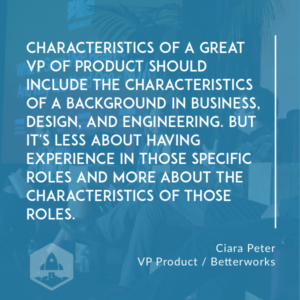
Ciara: When asked this, I personally default to this Venn diagram of there’s business here, design here, and engineering here. That’s typically where a lot of product leaders come from. But I think it’s less about having experience in those specific roles and what characteristics of those roles are important.
From a business perspective, I would say that being analytical, being data driven, and being able to communicate to all your constituents is why maybe someone would say an MBA makes a good product leader.
From the engineering side, a great VP of product needs to understand how to scope things and how to make really, really crisp tradeoffs.
On the design side, we know that there’s a lot of enterprise folks here today, and it’s different than 10 years ago. You have to compete with the user experience of all of the consumer products that are out there.
A deep user empathy and embedding that into your process is what’s really important. If you are data driven, user centric, and able to make really, really concise decisions, then I think you can come from any background.
Satya: Jon, I imagine you share that perspective in some ways.
Jon: Exactly. I don’t think there’s a specific education or even previous job, it’s a bunch of those traits you’re looking for, and a lot of the user empathy thing. We’re talking about things like taste. Do you have good product taste?
Something we’ve done is that we’ve hired a bunch of people out of our customer support group of folks because we saw that they knew the customer backwards and forwards and had good instincts as to what they liked and didn’t like. They knew the product all the way through.
They had already built relationships with the engineering group and people said, “Oh, yeah. If that person escalates something, it’s a real thing.” That’s 75 percent of what you need and we teach them the rest.
Satya: I always talked about product management, including being a VP of product, is more attitude than aptitude. It’s a state of mind and you have to have certain ways of thinking and certain characteristics that are all about your attitude and how you approach things that make you a great VP of product.
Along those lines, when is the right time, to the title of the panel, when’s the right time? What are the early warning signs that you need a VP of product? Maybe, Jon, you can start because you’re a founding VP of product but obviously have joined companies as a product leader as well.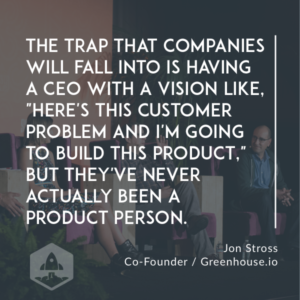
Jon: The trap that companies will fall into is that you get a CEO with some vision of, “Here’s this customer problem and I’m going to build this product,” but they’ve never actually been a product person.
Breaking down that kind of generic vision into a card that an engineer can work on today, there’s a whole bunch of stuff that happens in the middle there. The truth is there’s a whole discipline to software development, and if you’re going to be a SaaS company, you have to be really good at it.
For our company, both me and my co founder built tons of software for 20 years, me as a product person, him as engineer. We were able to get away with not having a VP of product because I’m kind of doing it still.
For companies who don’t have that, or who are started by a salesperson and an engineer or something, there is a missing function there and it’s going to be a trap to think, “We don’t need that. I know what I want the product to be like.” It’s like, “Hmm, there’s more to it than that.”
Satya: Ciara, you were the first non founding hire at BetterWorks. What led them to believe that they needed a VP of product at that point?
Ciara: If everyone sees the name on the panel, it’s “The Time is Now.” I think what it is is when you can add to that CEO’s vision. At the time, our CEO had a vision, and having some of the product experience and domain experience, I was able to maybe pull out some of the ways to execute on that vision.
It really is a matter of, how much time does the CEO or the founders have to invest in making sure that the details are right and making sure that the plan is in place so that you’re not going into work every week saying, “What are we going to build this week?” Agility is great but the strategy is necessary. I think earlier is better.
Satya: Zack, you joined Rainforest when it was about 70 people and, if I remember right, there’s a founder who has a strong product mindset. What was the signal to them to bring you on board?
Zack: I think two things. One is, once you go over a hundred customers, and the CEO or the CTO, one of them usually is the product person, right?
When they’re just too busy and they have to support sales, you have to get the VP of product to scale the organization, to really make it happen, and you also start to get so many things. Get some customers and get the feedback and really scale that. That’s really hard.
Those were the big two signals they think that with just too many customers, less time, they just have to get that. The reality is that they have to compromise where they can hire a VP of marketing, they hire a VP of sales. It’s a really big tradeoff.
When you get to a hundred customers, you just have to do that if you’re a SaaS is B2B, of course. Before that, you could compromise depending on how deep the founder and the CTOs are in the product.
Satya: There are a lot of companies like yours, start with a founder who has a strong product mindset or a CEO who is kind of the leader of the product and then a VP of product is hired. How do you make that relationship work? Maybe you can speak to your experience there at Rainforest.
Zack: That’s a great question. That was their baby. The product was your baby. They controlled everything, they micro managed that in a way, even.
In the first three months, you have to really make sure that you let them influence. Don’t really take big decisions. Create the platforms to collaborate between the CEO and the CTO and what you’re doing. Make sure you demand that time because, otherwise, you can’t really execute on that.
After some time, you have to go into a bit more of a low touch mode, make sure that you collaborate with them on the strategy. But also get to a point that you are in the details of the product and the customers very deep. Because they need to feel that you’re there, and you should be there because you’re the one that gets all the information.
Once you’re there, it gives them the comfort that you can actually run with things, of course, backed by data, things like that. To have those things going for you in the beginning until you can really run.
Satya: Ciara, you joined the company where the vision was the founder’s vision and then you were brought on very early. How did you manage that relationship and the direction of the product versus the vision of the founders?
Ciara: I used something that I call myself the idea ROI feedback loop. Most founders are going to have the big idea to start the company, and they’re going to have many ideas that are all top priorities.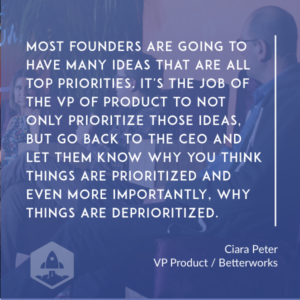
I think it’s the job of the VP of product to be able to not just prioritize those ideas but really do the analysis and go back to the CEO and let them know not only why you think things are prioritized, but it’s more important to let them know why certain things are deprioritized.
Tactically, we have a feature that we launched an MVP, maybe a little bit more MVP than we wanted to, but also shortly after that, we’ve found that there was a great demand to go into a new market. We had a choice, do we look at fixing some of these polished details on this one feature or do we go into this new market and…
People assume the CEO knows everything but they’re not going in and spending time in your data analytics products. The data that I presented was, 5 percent of our user base uses this and 30 percent wants this other thing. We made a really clear decision there.
People can overestimate the time the CEO has to invest in that. So, I think it’s the head of product’s responsibility to communicate that back so the CEO can then free up that brain space that they were investing in the lower priority items to generate new ideas.
Satya: Just as important as the relationship between the VP of product and the CEO is the relationship of the VP of product and the rest of the organization.
What’s the right structure to have for a team and where should the VP of products sit within a company to make that organization work well. Jon, you’ve worked at four or five different companies in product roles. What have you seen work well? What would you recommend?
Jon: I don’t think there’s a right answer. Different companies handle that really differently. We were just talking, product marketing, specifically we see sits sometimes in product, sometimes in marketing.
Does product sit under engineering or not. I’ve seen it all different ways and they all have their pros and cons. I don’t know if there’s a right answer.
For me, who has been a product manager at many different companies, being the founder and the product manager, way better.
[laughter]
Jon: So much easier.
Satya: Why is that, Jon?
[laughter]
Jon: Because you don’t have a boss. Ultimately, you just make the decision. I’m never going back. Ultimately, as you said, though, you do have to have nice relationships with everybody. Relationship with the VP of engineering, whether there’s natural or a healthy tension.
Like at this company, I have the utmost respect for him. I just love the guy and we love working together. That’s super valuable for the company, regardless of who reports to who, whoever it is.
Satya: Zack, you have a perspective? Given that you came into an existing organization, maybe had to rethink how the organization was set up.
Zack: Yeah. Coverity is an example when I joined, I actually reported to CMO, which eventually was changed and I reported to CEO. Again, it can work with many ways.
The one thing which all of you need to think about is if you want to empower somebody to define the strategy, he needs to have the power and access. That relationship of the VP of Eng that are kind of like love/hate in a way sometimes. If you want to be successful, just give him that environment.
Otherwise, it’s pretty hard, especially if it’s a product which is very technical then having somebody that is not technical that you report to is challenging.
Satya: I find a lot of time that companies bring in VPs of product when they begin to do more than one thing effectively, and then the VPs of product have to come in and figure out their own organizations as well.
Curious if you have a particular structure you like for product organizations and how those are set up. Ciara, I don’t know if you have any perspective on that.
Ciara: I think it depends on the company as well. Really, a lot of it is like, “Who are the people there? What are their skill sets?” One point that I did have some opinion on is where design sits.
I think in an enterprise organization where you have a different buyer and a different end user, you might have like three or four percentage you work with. I think it’s OK for design to be nested within product because you really have the exact same goals. You might just be executing on them differently.
In a more consumer type company, where the buyer or the user, they’re going through the marketing, through the acquisition workflow and then into the product, in that case, maybe consolidating those and up leveling the role of design to buy in brand design and product design would make sense.
Satya: Jon, do you have a perspective on either design specifically or product teams more generally?
Jon: Yeah. We’re making it small old pods, where you’ve got a product person and a designer and a bunch of engineers who own something.
Whether it’s a portion of the product, or a separate product, or the mobile app, or whatever, where they can have a shared backlog and a shared goal and can all own it together, and work on things through the lifecycle, from concept to post launch…
Satya: Those are long living teams. Not temporary teams.
Jon: That’s right. They may rotate people for the sake of learning, but ultimately if you just have one…like when we first started, we had a team of people building stuff, and at some point, you realize like, “Oh, everyone’s trying to know everything, and product managers are stepping on each other.”
You want to carve it up, and then the VP of product then has to have a shared vision that cuts across all of them to make sure that everything is still cohesive.
Satya: Zack, what about you? How have you set up your team?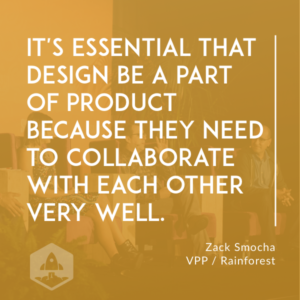
Zack: I think that design should be part of product. I think that it’s essential. The product and design just need to collaborate with each other very well. Product marketing could be on the marketing side depending on the company really and what it does.
But for me, it’s pretty simple. As long as you give somebody the ownership of something that they can own and have a strong KPI and attach dev team with that and designs, then you’re in a good place.
Satya: What about from a process standpoint? One of the things that VP of product has to focus on is execution. What tools or what processes work well in terms of getting the right velocity and quality from your teams? Jon, maybe you want to take a crack at that.
Jon: That could be a whole conference on its own…
Satya: Yeah, I know.
[crosstalk]
Satya: Do you use things like objectives and key results? Do you focus on continuous deployment? What are the things that you’ve embedded within your team?
Jon: Yes, many of those things. From the product planning process, there’s a whole annual product roadmap that’s sort of amorphous, that turns into a more crisp quarterly roadmap, that turns into a crisp, like, “What are we doing this week?” which is more product management driven.
With the engineering team, we’ve evolved over time because you’re going to have to as you go from 3 people to 40 or whatever. But we made the investments and doing everything they were talking about in the last panel around continuous delivery and continuous integration. We’re there now. [laughs]
I’ve just recognized that velocity is everything. If I know I could ship 20 things a quarter, I have to stress way less about the priority of those 20 things. If I’m like, “Ugh, maybe I can do three,” then it’s like a bloodbath deciding which three I’m going to do.
We spent a lot of time trying to figure out, how do we just keep velocity up? Which can be a bad thing, you turn into a feature factory, but if you know that you can push things through and you can learn and improve them, it makes some of the fights a little bit easier.
Satya: Ciara, what’s worked well for you and your teams?
Ciara: OKRs are super important. We do those every quarter. We have KPI, OKRs, we have objectives and key results around what we’re going to deliver and then more operational things.
Doing this as a team is really important. Actually, one that I want to bring up is, we don’t have a dedicated user researcher. We embed that into all of our process.
One of our OKRs is complete a hundred user research activities per quarter, and then engineers either spend a day with support or they do three sales calls.
The reason I think this actually has a lot to do with process is that everyone has these 10 interactions. They’re really deeply connected to our customers, and when it comes time to make a trade off, we have to make a difficult decision.
The more people already know going into that, the more logical that conversation is going to be and ultimately efficient it’s going to be because you’re not spending time making assumptions or doing mis discovery.
I think that connection to customer is something that the entire R&D organization, it’s a really important aspect of what they do.
Satya: Zack, what about you? Any particular tools or things that you’ve implemented that help with the execution and delivery.
Zack: Yeah. I agree with everything that was said over here. One thing that usually people forget, which I like to focus a lot on is really when you develop something and you actually roll it out, it’s after that that you start to monitor that and continue to actually do that.
Many organizations that I’ve seen, including where I worked it’s like, you develop something and then you just move to the next one. It’s really everybody’s doing it.
I found that we actually insist on monitoring that KPI and iterating on that and making more iterations on that, that’s actually a process which works very well and eventually connects you also with sales and the customer success, and everybody is actually using the feature.
The other thing which I found to be great is, go beyond the box of just product as a process. For example, if you want to go and develop your territories, your geo in Japan, I would give somebody, “Hey, you’re responsible for Japan. You go figure it out, make that thing happen for them. Fly there as much as you want, do that.”
I find that those processes that are coming from the side are really powerful because it makes the PM team connected with the business and they can get visibility and things like that. Those things that are like different, for me, work very well.
Jon: One other trick that I think I didn’t anticipate how powerful it would be, is we got into this pattern of really regular cadence every two weeks of each of those teams does a retro where it’s a a pretty structured format where a lot of things come up. What it turns into is each team become self healing.
I don’t think I got that. I think it originally started with a kind of a bitch session, and then over time, as everyone understands how to do it and how it creates, like, “Here are things we should fix,” and then they fix them, and everyone says, “Oh, wow, if I bring it up at the retro. It can actually get fixed.” Each team you see becomes self healing, which is a really incredible power to have.
Ciara: One last thing I would add is, something that works well for us, we have this meeting called the PDR, product design review, I know there’s tons of acronyms. What I like about it is it gets every stakeholder in one room once a week.
It’s head of eng, design, product, and all the leads of the team and then we go in reverse priority order. Like things that are being built now or need to be built. We’re like, “Let’s check all those boxes so we don’t have to have side conversations about it.”
Then once that’s done, if there’s time, then we go into more of the design and so we can do a formal design review but I find just making sure there’s times you just have everyone in the same room, it cuts so many meetings that people would need to have outside of there.
Satya: I love them. I’m a big fan of product reviews and product design reviews.
One of the tools I like within the context of that is just a documented user story which is a living document that anybody can refer to, whether it’s on a product management team or more broadly, that reflects what you’re building, why you’re building it, how you’re going to measure success, what the goals are.
Using that in the retro as well as a document, that captures the thinking and is shared broadly.
As you’ve probably picked up from everyone’s answers here on the panel, product management, being a VP of product is much more art than science and anytime you’re creating art, the key inputs are people, generally speaking.
I’m curious what you look for when you’re hiring your teams. What makes a great product manager that you try to hire and bring on board?
Ciara: I can take…
Satya: Ciara, you want to start?
Ciara: Yeah. There’s a quote that I really like which is, “Ideas are precious, but they’re relatively easy. Execution is everything,” from the legendary investor, John Doerr. The reason I like that quote is we’re in Silicon Valley and we’re in the tech industry and there are billions of ideas.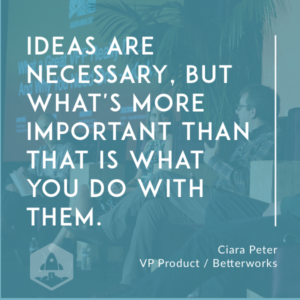
The person that’s kind of positioned as just like the idea guy. That’s great. Ideas are necessary, but what’s more important than that is what you do with them.
I think there are a couple of key traits that I look for. One is, are you operational and organized? Tactically, a quick question that I ask is, what is your operating system? Everyone should have some sort of operating cadence. That they do a few things regularly.
That gives a sense of, is it planned or is it more ad hoc? And that’ll give you a sense of how much kind of overhead management you’ll have to do. Decision making is a really great one.
As you mentioned, there is a lot of art in here but what you can’t understand is, what are the inputs that you think are important to ask?
What are the inputs that you think are important to making a decision? To see, are they diverse? Do they vary from project to project and does this person know how to approach getting the right information?
Secondly, give an example of a time where you’ve had to make a change mid flight. What I look for is, did that person go back and looked at the data and say, “Hey, stakeholder. Just so you know, this is what will happen,” or did they just take it and run with it and how did they communicate it?
The final thing is understanding how they’ll work with engineering and design. You can have them interview, but really actually a requirements document, like you just mentioned, is a great way to understand that.
We ask of designers to see their portfolio. We ask of engineers to do a code exercise, but we don’t really ask anything of product managers.
I think asking to see a requirements document or anything, if they’re a senior person, presentation, is very fair because what I want to know is, did they actually list the goals of the work inside of that document?
Because that’s where the engineers look and they’re not going to be in every conversation. It’s so important for morale, for people to know why they’re building the thing that they’re building. Is it organized? Does it have a hierarchy? I think you can tell a lot about…
Does it have the detail, the user stories? They don’t have to be an engineer or a designer, but they have to have empathy and know how that person works or have collaborated with them to have that information. That’s a really clear indicator.
Satya: Jon, what do you look for?
Jon: Get stuff done. Look for an example of them getting something done in a really difficult environment where there’s a bunch of things against them. As Ciara was saying, we do a project with them where we say, “I’m looking for a product sense.”
We’ll say, “Take some product that you use, that’s not ours, and have some complaint with it, and spec a feature to improve it, and then tell me why they haven’t built it and why they would build it.”
You get a lot there. You get their curiosity, like, can they actually answer that question? Some people don’t have that imagination, and that’s a terrible sign. Then, can they think beyond, “Oh, here’s the thing I want.” It’s like, but not everybody’s like you, what about the people who aren’t like you? How’s that going to work out?
Then we look at, can they speak all the different languages? Product managers connect with engineers, and marketers, and customers, and customer support. Can they thrive in that environment because they’re going to be in the middle of all those different people or are they two on one of those sides?
Satya: Zack, anything to add?
Zack: Yeah. I agree with your comment, especially on the sales side. It’s extra important. The other thing is I think product managers just needs to know how to context switch like 7,000 things a day.
I think it’s how you’re wired sometimes as a person, the act that you’re going to handle tons of files, you’re going to jump from one task to the other. If you don’t feel comfortable in that environment, then just probably don’t be a product manager.
When I transition people from different organizations, if I think of one thing which eventually caused them to actually stay in product or move ahead, was their ability to, after some time in the work, to say, “You know, I’m actually not reading all of my emails. But that’s actually OK?”
I’m just going to pause them, I’m going to do what’s important, which goes back to what they actually supposed to do and not do. That kind of character can be learned, but it’s really, really important.
Satya: A lot of the companies in the room may be in the process of hiring their first VP of Product.
A big key in figuring out who the right person to hire is to know what excellent looks like to begin with. What resources, what people, what tools have you used to try to figure out how to become a VP of Product, or how to identify great VPs of Product that you’ve had a joy of working with or cooperating with.
Zack: For me, it’s like I look into the experience. If somebody actually did a product, started when there was certain revenue and took it to some place, and give you the story behind that, and also the ugly stories. We had a churn issue, we had this thing didn’t work, kind of like the juice over there, and went for that. If you need a couple of times, for me is the most important thing.
It’s just something that you really have to experience to be able to drive that in my mind.
Ciara: There still is an opportunity for a playbook, a real product leadership playbook to emerge. What I would say is, if you have investors to leverage those networks as much as possible, because people, most Heads of Product have built their organizations in a home grown way. Those networks are just emerging.
I found that people are really gracious with what they will share, and they want to talk about it and share their experiences. Organically, to reach out to others.
Jon: Obviously, you want to run a nice structured interview process using Greenhouse. Plug. The only thing I’d say is, “Go through your engineers.” Engineers are typically very opinionated about product folks, and frequently in a negative way. When you go to engineers and say who’s the product person you’ve worked with, who you loved, you get a pretty meaningful answers.
Satya: That thing, it’s a great one. As you picked up a lot of the skills of VPs of Product and product managers are soft skills. The hack for finding a great VP of Product is to talk to product managers, because great VPs of Product have teams that will work with them over, and over, and over again.
If you can find those individual product managers and talk to them about who have been great in their careers, that’s an interesting hack for finding great VPs of product.
Thank you so much. Lunch is next for all of you, so we’ll end it here. I really appreciate your time.

